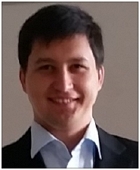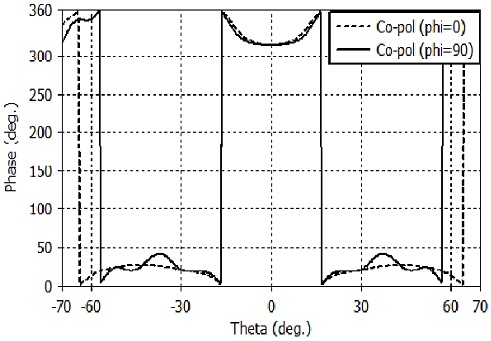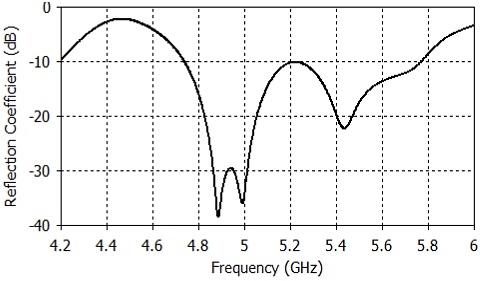
Design of a C-band Reflector Antenna with a Splash-plate Feed
Abstract
This paper presents an optimum design of a C-band reflector antenna fed by a splash-plate feed. The designed antenna consists of a parabolic reflector with an apex plate and a splash-plate feed integrated with a circular waveguide. The splash plate has a central cone for reflection reduction and a dielectric support structure for integration with a circular waveguide. An apex plate is placed at the center of the parabolic reflector for sidelobe reduction. An optimum antenna design has been obtained by suitable choice of reflector illumination angle, diameter and location of the splash plate, the shape and size of an apex plate, and by good impedance matching of the splash plate feed. The designed antenna operates at 4.8-5.7GHz with reflection coefficient of less than -10dB. At the frequency of 5.1GHz, the antenna has 30.8 dBi gain (67.3% aperture efficiency), 4.9° E-plane beamwidth, 4.7° H-plane beamwidth, -21.0dB E-plane sidelobe, -20.8dB H-plane sidelobe, and maximum cross-polarization gain of -5dBi.
초록
본 논문에서는 스플래시 플레이트 피드에 의해 급전되는 C-대역 반사경 안테나의 최적 설계를 제시하였다. 설계한 안테나는 꼭지판을 가지는 포물 반사면과 원형 도파관과 통합된 스플래시 플레이트 피드로 구성된다. 스플래시 플레이트는 반사 감소를 위한 중심부 원뿔과 원형 도파관과의 통합을 위한 유전체 지지 구조를 가진다. 부엽 감소를 위해 포물 반사경 중심에 꼭지판을 설치하였다. 반사경 조사각, 스플래시 플레이트의 직경과 위치, 꼭지판의 형상과 크기 등의 적절한 선택과 스플래시 플레이트 피드의 우수한 임피던스 정합을 통해 최적 안테나 설계를 얻었다. 설계한 안테나는 4.8-5.7GHz에서 반사계수 -10dB 이하를 가지고 동작한다. 5.1GHz 주파수에서 안테나는 30.9dBi 이득 (67.3% 개구효율), 4.9° 전계면 빔폭, 4.7° 자계면 빔폭, -21.0dB 전계면 부엽, -20.8dB 자계면 부엽과 -5dBi의 최대 교차편파 이득을 가진다.
Keywords:
reflector antenna, feed antenna, splash plate, optimum designI. Introduction
Reflector antennas are widely used as a high-gain, high-efficiency radiator in space/satellite communications, radio astronomy and point-to-point microwave links[1][2]. Reflector antennas with a self-supporting backfire feed offer structural simplicity as well as high efficiency[3][4]. They are popular in the SOTM(satellite on the move) communication terminals[5][6]. There have been many designs on the reflector antennas with a backfire feed where the design of the feed is the core task. Since its introduction[3], many variations in the design have been proposed mainly towards a view of improving the aperture efficiency and sidelobe and back-lobe characteristics[7]-[10].
James and co-workers investigated the theoretical design of a splash-plate feed where ray optics and edge diffraction were employed to show that a cone on the splash plate widens the feed beamwidth suitable for backfire feeds[7]. Foster and co-workers presented a dielectric-supported splash plate feed for reflector operating at 8.4GHz[8]. For 10.3-wavelength reflector, their feed achieved sidelobe level of -22dB with 54% aperture efficiency. Geterud proposed a wideband hat feed operating at 10.8~14.5GHz for a 53cm reflector meeting the M-x sidelobe envelope standard with 55% aperture efficiency[9]. More recently, Zho and co-workers presented a 1.02m reflector antenna fed by a splash plate feed at 27.5~30GHz. They achieved –20dB sidelobe level and 65% aperture efficiency[10].
In this paper, we present an optimum design of a C-band reflector antenna fed by a splash-plate feed. Our design effort has been concentrated on the reduction of the feed reflection coefficient and the first sidelobe level in the reflector's secondary pattern. In the following, the detailed design of the proposed antenna is presented. We used CST Studio Suite 2019 for antenna design.
Ⅱ. Antenna Design
Fig. 1 shows the structure of the proposed reflector antenna. The reflector is of parabolic type with a prime-focus feed. The feed is the core of the antenna whose design is critical to the antenna performance.
Fig. 2 shows the longitudinal cross section of the antenna that helps in the understanding of the operating principles of the antenna. The wave launched in a circular waveguide is reflected back at the splash plate toward the main reflector in a spherical wave, which is then transformed into a planewave by the parabolic reflector. The feed's phase center is placed at the focal point of the parabolic reflector.
'Field radiated by the feed effectively illuminates the reflector from angle θ1 to θ2 shown in Fig. 2. The central region of the reflector corresponding the feed angles from 0 to θ1 is determined by the splash-plate diameter. Waves reflected by the central region are blocked by the splash plate and thus do not contribute to the antenna's far-field gain. The diameter of the apex plate would thus be smaller than or equal to that of the splash plate.
In our design, the reflector diameter is 800.84 mm (13.62λ at 5.1GHz) and its focal length is 305.12mm (F/D = 0.381). The apex plate of diameter 151.58mm (0.189D) and thickness 10.74mm (8.07° slope) is employed for the reduction of the first sidelobe level. With the above dimensions, the feed illumination angle ranges from θ1 = 14.2° to θ2 = 66.5° as calculated from the following equation
| (1) |
where θ is the angle away from the feed axis and Dθ is the diameter of the circular contour made by intersection of the parabolic surface and a cone defined by the ray at an angle θ emanated from the focus.
Fig. 3 shows a transparent view of the splash-plate feed and Fig. 4 shows the longitudinal cross section of the feed with dimensional parameters. The splash plate is a circular metallic plate whose diameter and distance from the circular waveguide aperture primarily determine the feed's radiation pattern.
The first step in the feed design is to determine the diameter of the input circular waveguide. An ideal splash plate is the one that rotates the circular waveguide's far-field pattern while suppressing the radiation forward hemisphere. This observation tells us that the waveguide aperture size is so determined as if it directly illuminates the parabolic reflector.
A circular waveguide aperture excited with the incident TE11 mode shows the best E- and H-plane pattern symmetry (thus the lowest cross polarized radiation) and the smallest backward radiation when its diameter is 0.65 wavelength [10]. In this paper, a circular waveguide with inner and outer diameters of 41.90mm (0.71λ at 5.1GHz) and 46.02mm respectively is employed.
The next step in the feed design is the determination of the splash plate diameter d2 and the distance h2 between the circular waveguide and the splash plate. Existing results show that the splash plate diameter ranges from 1.5 to 2.5 wavelengths. For a given distance from the circular waveguide aperture, small diameters result in wider beamwidths. For a given diameter of the splash plate, the smaller the distance between the splash plate and the waveguide aperture, the smaller the feed's beamwidth.
Good feed performance is obtained when h2 ranges from 0.4 to 0.6 wavelength. Optimum values of d2 and h2 have been determined using the full-wave simulation software CST Studio Suite 2019. In the simulation the length of the circular waveguide is such that when the feed is installed on the reflector, the feed's phase center is at the focal point of the reflector.
The splash plate is integrated with a circular waveguide using a low dielectric constant dielectric material (PTFE, ϵr = 2.08, tanδ = 0.0002). The splash plate has a central metallic cone that reduces the multiple reflections between the circular waveguide and the splash plate. The multiple reflections introduce large ripples in the feed's radiation pattern as well as large reflection back toward the circular waveguide aperture.
Even with the central cone in the splash plate, the reflection coefficient in the circular waveguide is not small enough. The reflection coefficient is further reduced by employing a matching layer at the circular waveguide aperture and a taper in the dielectric materials. The match layer is a circular ring filled with air with inner diameter of 22.00mm, outer diameter of 41.90mm and height of 2.50mm. Below the matching layer, a dielectric cylinder of diameter 41.90mm and height 23.88mm is present. Then the dielectric cylinder's diameter is tapered from 41.90mm to 11.23mm over 21.52mm length. The outside contour of the dielectric support is chosen to be of parabolic shape for good radiation pattern characteristics.
Optimum dimensions of the feed have been obtained from detailed parametric studies using the CST Studio Suite 2019. Fig. 5 shows the effect of the splash-plate cone on the feed's reflection coefficient. The cone has a strong influence in the feed's reflection coefficient. Fig. 6 shows the effect of the matching layer and the dielectric taper on the feed's reflection coefficient. Again, the matching layer and the dielectric taper have a strong influence on the reflection coefficient.
A final design of the feed has been obtained whose dimensions are shown in Table 1. Fig. 7 shows the reflection coefficient of the designed feed. The feed's reflection coefficient is less than -10dB at 4.8~5.7GHz. When the feed is installed on the parabolic reflection, the reflection coefficient is modified to some degree and retuning is necessary.
Fig. 8 shows the co-polarized gain patterns at 5.1 GHz of the designed feed in the E and H planes and the cross-polarized gain pattern in the 45° plane. Over the reflector illumination angle from 14.2° to 66.5°, the gain variation is 8.7dB in the E plane and 6.0dB in the H plane. The maximum cross-polarized radiation in the diagonal 45° plane is -10dBi in the front direction and -4dBi in the backward direction.
Fig. 9 shows the co-polarized phase patterns in the E and H planes. The phase center of the feed is at 73.00mm from the circular waveguide open end in the direction of the splash plate. Over the reflector illumination angle 14.2°~66.5°, the phase variation is 50.0° (±25°) in the E plane and 38.0° (±16°) in the H plane. The phase variation can be reduced by shaping the splash plate and the central cone, which requires iterative optimization with a full-wave solution engine since the structure is not large compared the wavelength.
The designed feed is then employed to illuminate a parabolic reflector whose dimensions are previously given. Fig. 10 shows the gain patterns of the reflector antenna without an apex plate. The maximum gain of the antenna is 30.8dBi. In the E plane, the 3dB beamwidth is 4.4° and the sidelobe level is -15.3dB, while in the H plane, they are 4.8° and -16.9dB respectively. The maximum cross-polarized gain is 2.5dBi.
Fig. 11 shows the reflection coefficient of the feed installed in the parabolic reflector with an apex plate. By comparing Fig. 11 with Fig. 7, one can notice in some changes in the reflection coefficient of the feed due to the presence of the reflector. Fig. 12 shows the gain patterns of the reflector antenna with an apex plate. The maximum gain of the antenna is 30.9dBi (67.3% aperture efficiency).
In the E plane, the 3dB beamwidth is 4.9° and the sidelobe level is –21.0dB, while in the H plane, they are 4.7° and -20.8dB respectively. The maximum cross-polarized gain is -3dBi. With the apex plate, an improvement of 4~5dB is obtained in the sidelobe and cross polarization discrimination performance of the reflector antenna.
Ⅲ. Conclusion
An optimum design has been presented for a C-band reflector antenna fed by a splash-plate feed. Noble features of the design include the impedance-matching scheme for the feed and the use of an apex plate in the main reflector. With a combination of a conical structure on the splash plate, an air-filled ring and an end taper in the dielectric material supporting the splash plate, reflection coefficient of less than -10 dB at 4.8~5.7GHz has been obtained. The splash plate lowers the sidelobe of the reflector by 4~5dB. The designed reflector antenna shows aperture efficiency of about 67% and –21dB sidelobe level. Compared the work of Zho and co-workers, we obtained improvements of 1dB in the sidelobe level and 2% in the aperture efficiency. The design presented in this paper can be applied to the development of a compact and high-performance reflector antenna.
References
-
C. H. Lee, P. Xu, B. C. Ahn, J. H. Kim, and J. H. Bang, "Design of a monopulse reflector antenna for W-band seeker applications", The Journal of KIIT, Vol. 16, No. 2, pp. 75-82, Feb. 2018.
[https://doi.org/10.14801/jkiit.2018.16.2.75]

- S. Rao, L. Shafai, and S. K. Sharma Eds., "Handbook of Reflector Antennas and Feed Systems, Volume III Applications of Reflectors", Boston: Artech House, 2013.
- J. S. Foster, "Directive system for wave guide feed to parabolic reflector", US Pat. 2,605,416, 1952.
-
A. A. Kishk and L. Shafai, "Small reflector antenna with low sidelobes", IEEE Trans. Antennas Propagat., Vol. 51, No. 10, pp. 2907-2912, Oct. 2003.
[https://doi.org/10.1109/TAP.2003.816329]

- S. Yamamoto, S. Nuimura, and T. Mizuno, "A Ku band small reflector antenna using backfire primary radiator for satellite communication system on board vessel", 2012 International Symposium on Antennas and Propagation (ISAP), Nagoys, Japan, pp. 1273-1276, Nov. 2012.
-
O. K. Hancioglu, M. Celik, and U. Tumerdem, "Kinematics and tracking control of a four axis antenna for satcom on the move", The 2018 International Power Electronics Conference, Niigata, Japan, pp. 1680-1686, May 2018.
[https://doi.org/10.23919/IPEC.2018.8507963]

-
G. L. James and D. P. S. Malik, "Towards the theoretical design of splash-plate feeds", Electron. Lett., Vol. 11, No. 24, pp. 593-594, Nov. 1975.
[https://doi.org/10.1049/el:19750453]

- P. R. Foster, C. R. Yeoman, and S. M. Tun, "Performance of a small reflector with a splashplate feed", Proc. IEE Colloq. Reflec. Ant. 90's, pp. 7/1-7/4, May 1992.
- E. G. Geterud, "Design and Optimization of Wideband Hat-Fed Reflector Antenna with Radome for Satellite Earth Station", Ph. D. dissertation, Chalmers Univ. Tech., 2012.
-
L. Zhao, X. Bai, R. Li, and J. Xie, "A ring-focus antenna with splash plate in Ka-band", Int. Jour. Antennas Propagat. Online, Vol. 2018, Article ID 9790143, 8 pages.
[https://doi.org/10.1155/2018/9790143]

-
A. D. Olver, P. J. B. Clarricoats, A. A. Kishk, and L. Shafai, "Microwave Horns and Feeds", New York: IEEE Press, pp. 188-189, 1994.
[https://doi.org/10.1049/PBEW039E]


2018 ~ present : M.S Student, Radio and Communications Eng., Chungbuk National University
Research interests : Antennas

2019. 9 ~ present : Radio Communications Engineering Master’s Degree student, Chunbuk National University
2019. 9 ~ present : Applied Electromagnetics Laboratory, Research Assistant
Research interests : Antennas, applied EM

2013 : M.S. NTUU, Kyiv Polytechnic
2013 ~ 2014 : Research Engineer, PAO NPP "Saturn"
2015 ~ Present : Ph. D Student, Radio and Communications Eng., Chungbuk National University
Research interests : Antennas, microwaves devices and systens

1992. 12 : Ph. D., Electrical Eng., University of Mississippi.
1992 ~ 1994 : Researcher, Agency for Defense Development
1995 ~ Present : Professor, Radio and Communications Eng., Chungbuk National University
Research interests : Antennas, applied EM













